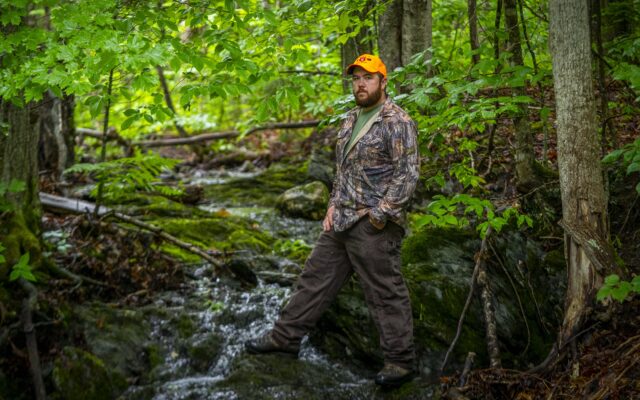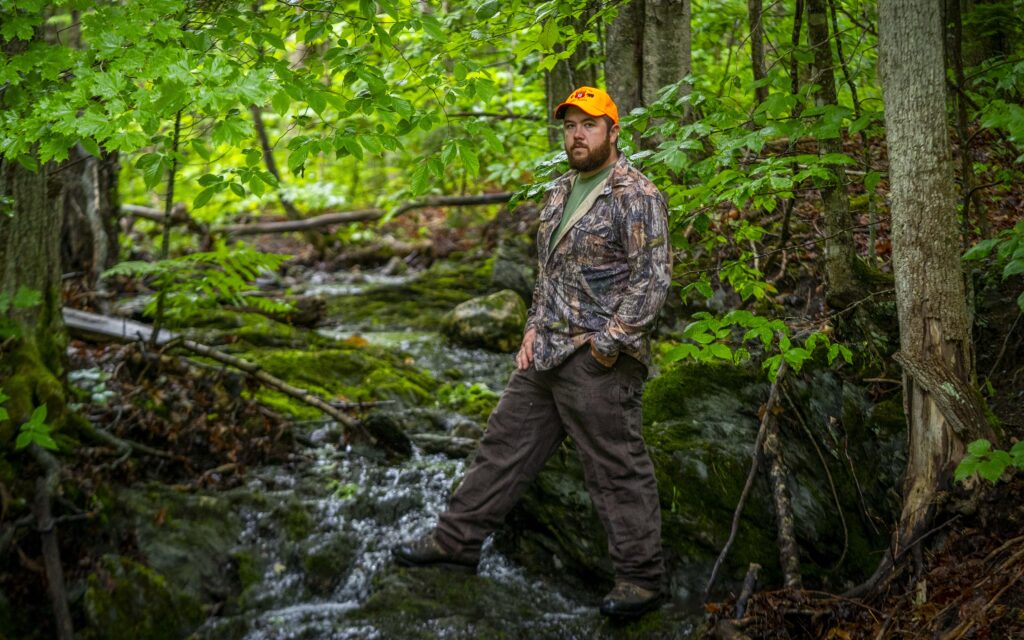
Conditions are perfect in the Maine woods for moose-killing ticks
By Lori Valigra, Bangor Daily News Staff
Brandon Bishop remembers vividly the first time he saw a dead moose infested with thousands of ticks.
The registered Maine Guide was snowmobiling in the north woods in 2012 and within a week found a dozen carcasses, mostly of calves, lying in the roads. Since then, moose partially bald from trying to dislodge mats of winter ticks have become an increasingly familiar sight.
“It was mindblowing to see the devastation of what a little tick could do,” said Bishop, who owns Foggy Mountain Guide Service in Charleston. “The moose basically get so many ticks on them that it makes them anemic. They just lay down and do not have the energy to get back up.”
Changes across Maine’s northern woods in recent years have created risky conditions for the state’s iconic moose herd. Warmer winters have boosted populations of ticks, which prey on moose throughout the cold season. Most concerning to state wildlife biologists is that half of the calves they have tracked in recent years do not survive their first year of life, and tick-infested female moose become less fertile.

REGISTERED MAINE GUIDE — Brandon Bishop, a registered Maine Guide, in the woods near his home in Charleston. Bishop is the owner of Foggy Mountain Guide Service.
Guides like Bishop, who leads 10 or more moose hunts every year costing about $5,500 each for a six-day trip, also are nervous about being able to continue to make their living from hunting. This year’s moose lottery held June 21 in Farmington for the fall hunt, when scientists also will resume studies on how to minimize the impact of ticks.
Lee Kantar, a moose biologist for the Maine Department of Inland Fisheries and Wildlife, will lead an effort to count winter ticks on dead moose, information that could help moose management by estimating how many calves might die over the winter. Scientists consider the state’s herd of around 70,000 healthy for now, but Kantar is worried about not enough calves surviving in the future.
Biologists also are looking at thinning the moose population, with the help of hunters, to decrease the number of winter ticks. October will be the final year of a study known as the adaptive moose hunt that allows more permits — 550 — in half of one remote hunting zone.
It could be tough to convince some people that to save a moose, you need to kill more of them to deprive the ticks of their food source, according to Benjamin Simpson, the Penobscot Nation’s big game biologist. The sad part about the state not offering more permits earlier is that moose died from the ticks anyway, Lee Schanz Jr., owner of Schanz’s Guide Service in Cornville, said.
Maine has the largest moose population in the lower 48 states. They are the biggest game to hunt in the state, making them a sought-after but carefully regulated centerpiece of the sporting culture here. Hunting-related purchases contributed another $938 million and supported 7,760 jobs last year, according to a 2024 report from the Sportsmen’s Alliance.
Unlike other types of ticks that move among different animals and people, winter ticks stay on a moose for their entire life. They attach to the moose in the fall and suck blood through the entire winter. They morph into an adult in March, which is when they suck the most blood from the moose. Early spring also is when there is little food around for the moose, which also must fend off predators including black bears and coyotes.
Some 30,000 to 90,000 ticks can be on a moose at one time, Kantar said, instead of only a few. Winter ticks are no danger to humans. The blood-engorged ticks look like a whole bunch of black grapes all over the moose, Chip Woodman, owner of Northeast Wilderness Outfitters in Monmouth, said.
“When you see it, it’s not something that you really forget,” said Byron Charles, co-owner of Spaulding Lake Outfitters in Oxbow, of sickly and dead moose in the spring.
Moose aren’t good groomers, Kantar said, so they rub up against trees to try to dislodge the winter ticks, also eroding their fur and leaving bare patches. Calves are more prone to die, because they weigh about 400 pounds in the spring, less than half of the adults, and can’t withstand the blood loss, he said.
The winter ticks tend to congregate in the neck and shoulder areas, in the armpits, groin, anus and ears, he said. It’s common in the spring to see animals with globs of ticks on them and bald spots. Calves may also die from exposure due to the hair loss. Moose hair is hollow inside and holds body heat.
Winter ticks are difficult to kill, although a winter freeze will destroy them. But to their benefit, winter temperatures have warmed 5 degrees compared with a century ago and it is the fastest-warming season, according to the Maine Climate Council’s 2024 update on the effects of climate change in Maine. Temperatures could rise another 2 to 10 degrees by the end of the century, depending on greenhouse gases. A shift of 2 degrees is enough to change the season by a week or more, said Sean Birkel, Maine state climatologist. The extra warmth and humidity of an extended fall could support more tick growth.
“A question I get a lot from people is, ‘will this winter be cold enough to kill the ticks?'” said Susan Elias, a tick expert at the MaineHealth Institute for Research in Scarborough. “The answer is almost always, ‘No.'”
Kantar of Maine’s inland fisheries department is studying various aspects of the winter ticks to see under what conditions they survive and to help predict how many calves might die over the winter. They make the prediction by counting the number of ticks along 4-inch cuts made across the neck, shoulders, ribs and rump of each moose, then use a formula to predict calve deaths.
High tick counts in 2021 foretold an explosion of deaths the following spring of 2022, when Kantar found that almost 90 percent of the moose calves he had tracked using GPS collars did not survive their first year of life. The tick population was unusually high that winter as temperatures rose up to 2.5 degrees above average, according to the National Weather Service.
Kantar said there were a few extreme events in the early 2000s in which more overwintering calves than usual were lost, but the numbers have ramped up since then. The death count can vary a lot, but more years than not he is seeing greater than a 50 percent loss of overwintering calves.
The state wildlife department is looking at other ways to study the winter tick to understand its patterns. One potential way is to have foresters cut trees to guide moose away from dense tick areas, Kantar said.
“That could inform us down the road so we can make recommendations to forest managers as to whether that could minimize the number of times that moose are coming into contact with ticks,” he said.
Lori Valigra reports on the environment for the BDN’s Maine Focus investigative team. Reach her at lvaligra@bangordailynews.com. Support for this reporting is provided by the Unity Foundation, a fund at the Maine Community Foundation and donations by BDN readers.